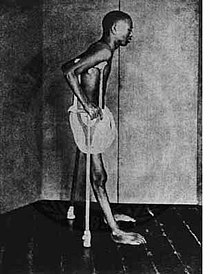
Back Beri-beri Afrikaans نقص الثيامين Arabic Beri-beri Azerbaijani بئری-بئری AZB Беры-беры Byelorussian Бери-бери Bulgarian বেরিবেরি Bengali/Bangla Beri-beri Catalan بێریبێری CKB Beri-beri Czech
| Thiamine deficiency[1] | |
|---|---|
| Other names | Beriberi, vitamin B1 deficiency, thiamine-deficiency syndrome[1][2] |
 | |
| A man from Batangas riddled with beriberi contracted in a U.S. Army concentration camp, circa 1902 | |
| Specialty | Neurology, cardiology, pediatrics |
| Symptoms | |
| Types | Wet, dry, gastrointestinal,[3] infantile,[4] cerebral[5] |
| Causes | Not enough thiamine[1] |
| Risk factors | Diet of mostly white rice; alcoholism, dialysis, chronic diarrhea, diuretics[1][6] |
| Prevention | Food fortification, Food diversification[1] |
| Treatment | Thiamine supplementation[1] |
| Frequency | Uncommon (USA)[1] |
Thiamine deficiency is a medical condition of low levels of thiamine (vitamin B1).[1] A severe and chronic form is known as beriberi.[1][7] The name beriberi was possibly borrowed in the 18th century from the Sinhalese phrase බැරි බැරි (bæri bæri, “I cannot, I cannot”), owing to the weakness caused by the condition. The two main types in adults are wet beriberi and dry beriberi.[1] Wet beriberi affects the cardiovascular system, resulting in a fast heart rate, shortness of breath, and leg swelling.[1] Dry beriberi affects the nervous system, resulting in numbness of the hands and feet, confusion, trouble moving the legs, and pain.[1] A form with loss of appetite and constipation may also occur.[3] Another type, acute beriberi, found mostly in babies, presents with loss of appetite, vomiting, lactic acidosis, changes in heart rate, and enlargement of the heart.[8]
Risk factors include a diet of mostly white rice, alcoholism, dialysis, chronic diarrhea, and taking high doses of diuretics.[1][6] In rare cases, it may be due to a genetic condition that results in difficulties absorbing thiamine found in food.[1] Wernicke encephalopathy and Korsakoff syndrome are forms of dry beriberi.[6] Diagnosis is based on symptoms, low levels of thiamine in the urine, high blood lactate, and improvement with thiamine supplementation.[9]
Treatment is by thiamine supplementation, either by mouth or by injection.[1] With treatment, symptoms generally resolve in a few weeks.[9] The disease may be prevented at the population level through the fortification of food.[1]
Thiamine deficiency is rare in the United States.[10] It remains relatively common in sub-Saharan Africa.[2] Outbreaks have been seen in refugee camps.[6] Thiamine deficiency has been described for thousands of years in Asia, and became more common in the late 1800s with the increased processing of rice.[11]
- ^ a b c d e f g h i j k l m n o p q r "Beriberi". Genetic and Rare Diseases Information Center (GARD) – an NCATS Program. 2015. Archived from the original on 11 November 2017. Retrieved 11 November 2017.
- ^ a b Adamolekun B, Hiffler L (24 October 2017). "A diagnosis and treatment gap for thiamine deficiency disorders in sub-Saharan Africa?". Annals of the New York Academy of Sciences. 1408 (1): 15–19. Bibcode:2017NYASA1408...15A. doi:10.1111/nyas.13509. PMID 29064578.
- ^ a b Ferri FF (2017). Ferri's Clinical Advisor 2018 E-Book: 5 Books in 1. Elsevier Health Sciences. p. 1368. ISBN 978-0-323-52957-0. Archived from the original on 2017-11-11.
- ^ "Pediatric Beriberi Clinical Presentation: History, Physical Examination". emedicine.medscape.com. Retrieved 2024-04-10.
- ^ Arányi J (1991-11-24). "[Cerebral beriberi with ophthalmoplegia as the leading symptom in an alcoholic patient]". Orvosi Hetilap. 132 (47): 2627–2628. ISSN 0030-6002. PMID 1956687.
- ^ a b c d "Nutrition and Growth Guidelines". Domestic Guidelines - Immigrant and Refugee Health. CDC. March 2012. Archived from the original on 11 November 2017. Retrieved 11 November 2017.
- ^ Hermann W, Obeid R (2011). Vitamins in the prevention of human diseases. Berlin: Walter de Gruyter. p. 58. ISBN 978-3-11-021448-2.
- ^ Gropper SS, Smith JL (2013). Advanced Nutrition and Human Metabolism (6 ed.). Wadsworth, Cengage Learning. p. 324. ISBN 978-1-133-10405-6.
- ^ a b Swaiman KF, Ashwal S, Ferriero DM, Schor NF, Finkel RS, Gropman AL, Pearl PL, Shevell M (2017). Swaiman's Pediatric Neurology E-Book: Principles and Practice. Elsevier Health Sciences. p. e929. ISBN 978-0-323-37481-1. Archived from the original on 2017-11-11.
- ^ "Thiamine Fact Sheet for Consumers". Office of Dietary Supplements (ODS): USA.gov. Archived from the original on October 29, 2017. Retrieved April 10, 2018.
- ^ Lanska DJ (2010). "Chapter 30 Historical aspects of the major neurological vitamin deficiency disorders: The water-soluble B vitamins". History of Neurology. Handbook of Clinical Neurology. Vol. 95. pp. 445–76. doi:10.1016/S0072-9752(08)02130-1. ISBN 978-0-444-52009-8. PMID 19892133.
© MMXXIII Rich X Search. We shall prevail. All rights reserved. Rich X Search